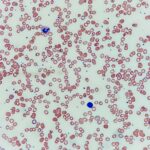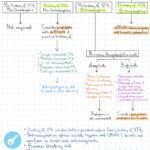
The management of individuals with sickle cell disease (SCD) or sickle cell anemia (SCA) is Individuals should be comprehensive and involve a multidisciplinary team. SCD can have a profound impact on the quality of life of patients suffering from this condition. Nevertheless, there are still only a few specialized centers throughout the United States that are dedicated to the care of patients with SCD. Therefore, healthcare practitioners must become acquainted with the clinical manifestations, complications, and management of patients with SCD.
We covered the clinical manifestations, diagnosis, and complications of SCD/SCA in our previous post:
Management of Acute Complications of Sickle Cell Disease
Acute Vaso-occlusive Events (VOEs)
Pain is the most common complication of SCD. Pain is caused by ischemia due to entrapment of deformed or “sickled” red blood cells in the microvasculature. Most patients deal with their painful episodes at home but some may be severe enough to seek medical attention. Specialized centers have infusion clinics where patients can be treated and receive intravenous fluids and medications. Patients may need to visit the emergency department (ED) if no other option is available. The most common triggers for painful episodes include exposure to cold, dehydration, infection, and stress.
Pain Management
- Rapid pain control is crucial. The goal is to administer the first pain medication dose within 60 minutes of arrival at the ED. Reassess pain every 30-60 minutes.
- Pain assessment tools can vary but the most important is the patient-reported scale (even though it is subjective). Laboratory data, vital signs, and other trends do not accurately assess pain.
- Intravenous opiates are the mainstem treatment (specialized centers usually have an elaborated pain management plan with specific dosage). Morphine and hydromorphone (Dilaudid) are the two most commonly used drugs.
- Intravenous opiates can be used intermittently or continuously (pump). Pumps are generally preferred as they offer both a basal rate and bolus administration of opiates which can be more effective in controlling pain.
- Consider NSAIDs (usually ketorolac) for 5 days as an adjunct to therapy.
- Intensive care unit (ICU) admission may be necessary if pain control is not adequate with opiates for administration of ketamine.
- Regional anesthesia can be considered as well.
- Other important interventions:
- IV hydration with hypotonic solutions (usually dextrose in half normal saline).
- Administer oxygen if hypoxia is present.
- Incentive spirometry helps with alveoli recruitment and can help prevent atelectasis and infection.
- Investigate and treat infection as appropriate.
Acute Chest Syndrome (ACS)
ACS has a high mortality and is important to recognize and treat promptly. It can be indistinguishable from pneumonia and has similar clinical features. Therefore, if a patient has fevers, chest pain, dyspnea, cough, and hypoxia, ACS should be suspected.
Most patients will have imaging findings which usually occur as a new lung infiltrate. However, changes may take more than 12 hours to occur. ACS generally occurs in the first 24-72 hours of an acute painful episode. The causes include lung infection, pulmonary embolism, fat embolism, and hypoventilation from pain, opiate use, and other factors.
Treatment recommendations for ACS:
- Similar recommendations for pain control as discussed in the treatment of VOEs.
- Empiric antibiotics with community-acquired pneumonia coverage.
- Blood transfusions: If there is lobar involvement, hypoxemia (PaO2 <90% on room air) or increasing oxygen requirements, and a drop of hemoglobin >2 g/dL from baseline (with hemoglobin at least <11 g/dL) –> transfuse 1-2 units of red blood cells.
- If patients are not improving with transfusion and other supportive measures –> consider red blood cell exchange (exchange transfusion).
- Exchange transfusion: removal of sickled RBCs for non-sickle cell RBCs. This needs to be coordinated with the blood bank and whichever service in your institution is in charge of the placement of central IV access.

Stroke or Cerebrovascular Accident (CVA)
Stroke is a common and morbid complication of SCD occurring in approximately 24% with HbSS disease and 10% of HbSC disease by age 45. The risk of stroke increases with age and if there are other accompanying cardiovascular risk factors such as hypertension. Transcranial Doppler (TCD) is used in children for screening of stroke risk (<200 cm/s velocity in TCD is associated with a stroke-free risk of 93% for the next 40 months).
Key principles in the treatment of stroke in SCD:
- Obtain CT head without IV contrast as an initial test as strokes can be both hemorrhagic and ischemic.
- Consider TPA or thrombectomy with similar criteria to patients without SCD.
- If more than 4.5 hours after onset of symptoms, consider simple transfusion or exchange transfusion with goal hemoglobin >10 g/dL and Hbs level of 15-20% (lower than the stroke prophylaxis recommended goal of HbS <30).
Stroke Prevention
- The ASH 2020 guidelines recommend screening patients with HbSS and HBsB0 disease with annual TCD between the ages of 2-16.
- If abnormal TCD (>200 cm/s), start a regular transfusion program for 1 year with a goal of an HbS <30 (in hemoglobin electrophoresis) and hemoglobin >9 g/dL followed by consideration of hydroxyurea at the maximum tolerated dose.
- The goal of HbS <30 is associated with a stroke risk reduction of 92% (STOP trial).
Splenic Sequestration
Splenic sequestration occurs when there is vaso-occlusion inside the spleen with the pooling of significant amounts of blood with a consequent decrease of blood volume in the circulation. Clinical features include those of shock with tachycardia, hypotension, diaphoresis, and others. Splenic sequestration occurs in patients who still have some functional spleen tissue which is usually the milder form of SCD (HbSC, HbS/B+). A drop of >2 g/dL of hemoglobin from baseline with accompanying hypovolemic features should make the suspicion of splenic sequestration. Treatment is slow volume depletion with blood transfusions, administered one at a time to avoid hyperviscosity and volume overload.
Acute Sickle Hepatopathy
- Gallstone disease: Can present as biliary colic or cholecystitis and is managed similarly to patients without SCD.
- Acute hepatic crisis: Vaso-occlusive event inside the liver causing right upper quadrant abdominal pain, elevated bilirubin (usually <15), and elevated liver enzymes. Usually, a milder form of liver failure is treated with supportive care and consideration for exchange transfusion.
- Acute intrahepatic cholestasis: A more severe form of acute hepatic crisis with significant elevation of liver enzymes and bilirubin and other complications of severe liver failure such as coagulopathy. Treatment includes blood transfusions and supportive care.
- Hepatic sequestration: Similar to splenic sequestration, usually associated with a drop of > 2 g/dL in hemoglobin from baseline associated with shock. Treated with blood transfusions.
Acute Renal Complications in SCD
- Renal papillary necrosis: Medullary infarction due to sickle cell obstruction of the microvasculature. Presents with hematuria with or without flank pain. Treated with hydration, and urine alkalization to help decrease sickling of cells, and relieve obstructions if present.
- Acute renal failure: Similar to acute intrahepatic cholestasis, a more severe form of renal dysfunction due to profound microvascular obstruction. Supportive treatment and renal consultation are recommended.
Acute Aplastic Crisis
- Associated with parvovirus B19 infection and seen mostly in children (slapped cheek fever).
- Anemia is generally of gradual onset and with a decrease of 3-6 g/dL of hemoglobin from baseline.
- Treatment is supportive and can include blood transfusions as well.
Priapism
- Sustained extremely painful erection lasting >4 hours. Can lead to permanent erectile dysfunction if untreated.
- Treatment includes supportive measures, urology consultation for possible local therapies to relieve compartment syndrome, and oral vasoconstrictors such as pseudoephedrine.
Long-term Management of Sickle Cell Disease
The overall management of sickle cell disease in the long term focuses on achieving a decrease in HbS and the risk of acute and chronic complications of the disease. There are many interventions and medications used to achieve this goal.
Medications Used in Sickle Cell Disease
Hydroxyurea
Hydroxyurea increases the production of fetal hemoglobin (HbF) which is more stable than HbS and improves RBC hydration decreasing sickling. Hydroxyurea also has vasodilatory effects helping with blood delivery to tissues. Hydroxyurea has proved to reduce painful crises, ACS, transfusion needs, hospital admissions, and mortality in several studies of patients with SCD. It is one of the crucial medications to be considered for the treatment of SCD.
Indications for the Use of Hydroxyurea:
- Severe SCD is defined as >3 pain crises per year.
- 2 or more episodes of acute chest syndrome.
Hydroxyurea can also be considered in other settings including increased hemolysis, pulmonary hypertension, chronic recalcitrant ulcers, and symptomatic anemia with alloimmunization, among others. The starting dose of hydroxyurea is 15 mg/kg/day. The dose can be increased as tolerated with a goal absolute neutrophil count >1.5.
Side Effect Profile of Hydroxyurea:
- Myelosuppression: particularly neutropenia (onset 7-10 days and recovery in 7-10 days of discontinuation). Anemia can be a limiting factor if the hemoglobin level is <5.3 g/dL.
- GI upset: abdominal pain, nausea, vomiting, and mucositis (dividing doses in the day helps with side effects).
- Skin toxicity: rashes, erythema, hyperpigmentation, dry skin, atrophy, and pruritus.
- Radiation-recall skin reaction.
- CNS symptoms: headaches, dizziness, confusion.
- Hepatotoxicity: mostly elevation of liver enzymes and bilirubin.
- Teratogenicity: Avoid in pregnancy and perform a pregnancy test before starting the medication.
How to Monitor Hydroxyurea After Starting:
- Start low doses and increase as tolerated to the maximum tolerated dose (15 mg/kg/day). Adjustments should be done every 8-12 weeks as hydroxyurea takes time to work.
- Monitor blood counts at least every 4 weeks and adjust as appropriate.
- Blood count thresholds to hold/stop hydroxyurea:
- Absolute neutrophil count (ANC) >1,500 cells/mm3.
- Platelets >80,000 cells/mm3.
- Monitor renal and liver function. If the creatinine clearance is <60 mL/minute, reduce the dose by one-half.
- Contraception to avoid pregnancy due to teratogenicity.
L-glutamine
- An antioxidant that could help reduce oxidative stress.
- Powder form (5-15 gr) given twice daily.
- Helps decrease the frequency of VOE and hospitalizations.
Voxelotor
Hemoglobin S polymerization with subsequent sickling is a major pathophysiologic mechanism of disease in SCD. Voxelotor is an inhibitor of hemoglobin S polymerization by reversibly binding to hemoglobin providing increase affinity of hemoglobin S to oxygen molecules.
Important Facts About Voxelotor:
- Oral medication, 1500 mg daily dosing.
- HOPE trial (phase 3 randomized clinical trial) showed a higher response in hemoglobin levels (51%) with voxelotor 1,500 mg daily when compared to placebo (7%).
- A good option for those with significant anemia as it improves hemoglobin levels.
- Adverse events are mostly gastrointestinal including nausea, vomiting, and diarrhea.
Crizanlizumab
Human monoclonal antibody that aims P selectin which is an adhesion molecule in the endothelium of blood vessels. In sickle cell disease, there is abnormal rolling and adhesion of sickle cells into the blood vessels causing damage and microvascular obstructions. Crizanlizumab mediates the abnormal function of P-selecting improving the flow of sickle cells in blood vessels and decreasing vaso-oclussion.
Important Facts About Crizanlizumab:
- Intravenous infusion is given over 30 minutes every 4 weeks.
- Indications: Frequent VOEs, acute chest syndrome, and lack of response to hydroxyurea.
- Phase II trial SUSTAIN led to a 45% reduction in hospitalizations. Approved by the FDA in 2019.
- Adverse events: Nausea and vomiting, joint and back pains, low-grade fever.
- Can cause pseudothrombocytopenia due to platelet clumping when blood is collected in EDTA tubes. Consider sodium citrate tubes if suspected.
- Infusion reactions are rare but have been reported.
Blood Transfusions
There are two main ways of administering blood products in sickle cell disease: simple and exchange transfusions. Simple transfusions is the administration of packed red blood cells to patients. Exchange transfusions involve the exchange of the patient’s blood with HbS with equivalent volumes of non-HbS blood. Here are important concepts to consider regarding blood administration:
- Simple transfusions: Can be administered as needed or as part of a transfusion program (usually administered every 4 weeks).
- Manual exchange transfusion: It involves manually removing a portion of the patient’s blood and replacing it with donor blood to reduce the percentage of sickle hemoglobin (HbS) and increase normal hemoglobin (HbA). During the procedure, small amounts of blood are withdrawn fromthe patient while transfusing donor red cells. The patient’s are carefully monitored and fluid balance status should be kept as even as possible.
- Automated exchange transfusion: It involves the use of specialized apheresis machines to remove sickle RBCs and replace them with donor RBCs. These machines separate and remove the patient’s red cells through centrifugation while simultaneously transfusing healthy donor cells, allowing precise control over the amount of blood exchanged. It requires a central venous catheter for higher flow rates, blood typing (coordination with blood bank), and cross-matching to ensure compatible blood units. Automated exchange transfusions are faster and more efficient than manual methods, but require central access and are not readily available in all institutions.
Acute Indications for Blood Transfusions in Sickle Cell Disease
In general, simple blood transfusions are considered when there is a drop in hemoglobin level below 2 g/dL from baseline combined with the following criteria:
- Transient red cell aplasia
- Splenic sequestration
- Hepatic sequestration
- Mild acute chest syndrome
- Complicated painful crises
- Acute blood loss
Exchange transfusions should be considered in the following scenarios:
- Acute stroke: ischemic or hemorrhagic
- Acute chest syndrome
- Acute multiorgan failure
- Acute intrahepatic cholestasis
- Acute ocular vaso-occlusive event
Importantly, it is recommended to aim for a hemoglobin level below 10 g/dL as patients with sickle cell disease are at risk for hyperviscosity syndrome.
Chronic Transfusion Indications in SCD
In general, chronic transfusions are recommended for patients with stroke and ACS history. The goal is to decrease HbS <30% and a target hemoglobin level of 9-10 g/dL. Here are the main considerations:
- Primary prophylaxis: Mostly used for primary stroke prophylaxis.
- Secondary prophylaxis: Recommended for secondary stroke prevention and when there are 2 or more episodes of ACS in one year despite the use of hydroxyurea
Complications of Blood Transfusions in SCD
Hematologists in general try to avoid transfusions in patients with SCD unless there is a clear indication as mentioned above. The complications of blood transfusions in patients with SCD are:
- Transfusion reaction risk.
- Risk for alloimmunization (up to 40% of patients could develop these complications) including acute and chronic hemolytic transfusion reactions that make management of blood products extremely challenging. Anti -Kell, -C, -E antibodies account for about 2/3 of the cases. Patients at risk for acute hemolytic reactions could be considered for steroids, IVIG, and rituximab before the administration. These patients should be managed with a multidisciplinary team and involvement of the blood bank.
- Iron overload: Leading to similar clinical features than patients with hemochromatosis. Iron overload is minimal in exchange transfusions.
Hematopoietic Stem Cell Transplantation (HSCT)
Hematopoietic stem cell transplantation (HSCT) is one of the few available curative treatment for sickle cell disease (SCD). It involves replacing the patient’s defective stem cells, which produce sickled red blood cells, with healthy stem cells from a compatible donor. These new stem cells generate normal red blood cells without the HbS defective characteristics that lead to SCD. The main risks of HSCT are infection during and after receiving their HSCT and graft-versus-host disease (GVHD). Here are the main considerations for HSCT in SCD:
- SCT can be curative for patients with SCD.
- HLA-matched sibling transplants have the best outcomes.
- The 5-year overall survival (OS) for < 16 year olds is 95% and over 15 years of age is 81%.
- Conditioning in general is done with reduced intensity.
Gene Therapy in SCD

Gene therapy is one of the newest therapies available in a few centers throughout the US. The goal is to correct the genetic defect responsible for the production of abnormal hemoglobin (HbS). The process involves modifying the patient’s own hematopoietic stem cells to either introduce a normal beta-globin gene or silence genes that promote sickling. The modified stem cells are then reinfused into the patient, allowing them to produce healthy red blood cells without SCD. Here are the main considerations for gene therapy in SCD:
- Gene therapy offers the potential for a one-time, curative treatment.
- An alternative to HSCT.
- The steps include stem cell mobilization with plerifaxor and apharesis, collection of hematopoietic stem cells (HSC), gene addition or editing, conditioning usually with busulfan myeloablation, and re-infusion of modified HSC into the patient.
- Gene addition can be performed with Lovotibeglogene autotemcel (lovo-cel, Lyfgenia).
- Gene editing can be performed with Exagamglogene autotemcel (exa-cel, Casgevy) through CRISPR/Cas9 gene-edited cell therapy.
- Extremely costly and not yet widely available to patients around the United States and the rest of the world.
- Importantly, loss of fertility and secondary malignancies can occur with busulfan conditioning.
Sickle cell disease is complex and involves a multitude of challenges and therapeutic options. We hope you enjoyed this post! Please, leave us any comments or questions below. Feel free to rate our post using the star system below if your time allows. Your feedback is important to us. Thank you!





